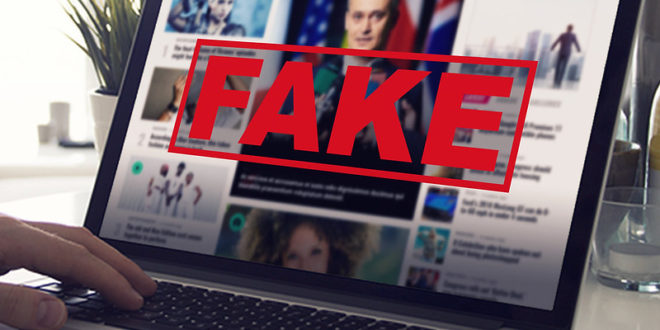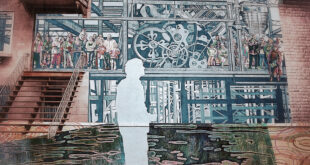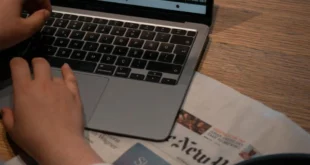Issue 30, summer/fall 2020
https://doi.org/10.70090/AE20CCDC
Abstract
This article reviews the most recent academic scholarship and professional literature pertinent to fake news, in order to provide a better understanding of its challenge in the digital era. In so doing, the article outlines fake news phenomenon, its political and financial motives, its impacts on quality journalism, as well as the controversy surrounding its effects, particularly with regard to social media, drawing examples from Germany, the United States, and Egypt, and discussing possible practices to counter the digital challenge of fake news.
--
Fake news is best described as counterfeit news, as opposed to genuine news that go through conventional journalistic processes. Any news story that is not genuine but presented as such, with the intent to deceive, is counterfeit news (Fallis and Mathiesen 2019). Based on two dimensions of facticity and deception, Tandoc, Lim, and Ling (2018, 137) proposed a typology of fake news types, namely, “news satire, news parody, fabrication, manipulation, advertising, and propaganda.”
Fake news reflects the collapse of the old news order, and the beginning of public communication chaos. A struggle over the truth amongst governments initiating war propaganda, elites, and institutions eager to dominate news coverage has been reinvigorated. Traditional journalistic efforts to provide quality reporting also became difficult to sustain in the thick of an unstable hierarchical order (Waisbord 2018). It is in that sense that fake news became a “floating signifier” between different hegemonic projects looking to represent society and its structures (Farkas and Schou 2018).
The world of fake news forms its own sphere of reality, creating a sense of confusion that undermines the ability to distinguish between verifiable assumptions and unfounded claims. The motives are either political, as a type of effective propaganda, or financial, as false intriguing messages that seem credible, generating advertising revenues through online clicks (Pörksen 2018).
Fake news has been used for political ends by certain countries to target their opponents’ national security and create chaos, or by internal parties to communicate agendas and discredit opponents–especially during elections. According to Sängerlaub (2020), who leads the project “Disinformation in the Digital Public Sphere” in Stiftung Neue Verantwortung (SNV) and investigated cases of disinformation or fake news, an example of the aforementioned political disinformation is the criminal case of Lisa F. Lisa, an underage girl of Russian heritage from Berlin, who disappeared for over twenty-four hours in 2016, then later falsely claimed that she was raped by three strangers. This event was used by the Russian television network, RT, against Germany, provoking demonstrations by Russia Germans that same year.
Another political motive for spreading fake news is the attempt to influence election results. Fake news on social media during the 2016 U.S. presidential election was investigated by Alcott and Gentzkow (2017), who found that Trump supporters shared 115 fake stories 30 million times on Facebook, as compared to 7.6 million shares for 41 stories in favor of Clinton. One fake news story that surpassed one million Facebook shares claimed that Pope Francis endorsed Trump.
Defamation of opponents during election cycles is a further motive to create fake news. According to Kim, Moravec, and Dennis (2019), Pizzagate, a conspiracy theory that started on Twitter and spread on Facebook during the 2016 U.S. presidential election, accused the Democratic Party of running a child abuse ring in a pizzeria in Washington. “The influence of fake news did not stop at the election,” as the pizzeria owners and employers were harassed and attacked by an armed man in response to the rumors (Kim, Moravec, and Dennis 2019, 932). Accordingly, unreal news could lead to real world danger (Pörksen 2018).
In January 2021, Twitter permanently suspended the account of Donald Trump, the U.S. President at the time, following tweets violating the platform’s guidelines. Twitter explained how Trump's latest tweets, such as the one about not attending Biden's inauguration, could have been perceived by supporters as an encouragement of the violent storming of the U.S. Capitol, and as a confirmation of electoral fraud in the 2020 U.S. presidential elections (Twitter Inc. 2021).
In addition, disinformation is used by political parties to communicate their agendas to the public. Krüger (2018) discussed the changes in the media at times of social fears and tendencies towards division, which had fueled the rise of the right-wing populist party Alternative for Germany (AfD) as the third-strongest political force in the 2017 Bundestag federal election. By tracing structural changes in the public sphere from the mid-1980s, and the transformation of the classic German media landscape through digitization, globalization, individualization, and economization, Krüger (2018) argued that some fears that drove Germans to vote for AfD had been indirectly related to media changes in an era of globalized digital network media. The AfD channeled the fears and worries about the future and associated all issues of social justice to possible consequences of accepting refugees and immigration.
An example of this is when, at a folk festival in Schorndorf in Baden-Württemberg in 2017, a thousand young people gathered, among which there were a number of individuals of immigrant backgrounds. When a few of them rioted, Deutsche Presse-Agentur (DPA) described them as 1000 rioting young people, right-wing populists framed them as 1000 rioting immigrants, and Christian Democratic Union (CDU) leader, Jens Spahn, referred to Schorndorf as an example of how difficult integration is (Sängerlaub 2020).
The spread of fake news online also helps hoax news sites make substantial sums of money from online advertising. Media infrastructures and industries, according to Braun and Eklund (2019), create an incentive structure for hoax publishers, where authentic digital journalism organizations depend on the same economic system and online advertising for livelihood as the hoax ones– particularly after the decline of traditional advertising. Financial motives behind fake news triggered Facebook to announce an initiative to curb the economic incentives of disinformation. includes identifying false news via third-party fact-checking organizations, detecting fake accounts, enhancing machine learning, and hardening the advertising process for spammers (Facebook Media Blog, n.d.).
The significant problem of “empathic media”, or emotionally targeted news produced by algo-journalism, was addressed by Bakir and McStay (2018) who examined the 2016 US presidential election campaign to identify fake news problems. They did so via textual analysis and meetings, pinpointing the role of digital advertising in causing and combating fake news. Algorithms on platforms are also to blame for information quality, because they are designed to keep people surfing, which cannot be easily achieved with factual essays, but by sensational content (Sängerlaub 2020).
Notable media institutions are losing their leading role due to platform algorithms or the hurried processing of information for mobile users. This is a result of how information of different qualities flow together indiscriminately on one platform. Consequently, an equivalence doctrine occurs, in which information that leaves the wrong impression of equally meaningful competent interpretations is presented (Pörksen 2018).
Continuous exposure to online misinformation reduces the moral and ethical onus on individuals publishing and sharing false information, regardless of their beliefs. That is, repeating misinformation reduces moral condemnation by making it feel instinctively true, and thus, easier to spread. Participants tended to share repeated headlines more, and to publish their approval of headlines perceived as less unethical, and to perceive headlines as such due to repeated exposure, even in contrast with labels and popular judgments (Effron and Raj 2020).
Television news journalists within the United States were interviewed by Benham (2019) regarding fake news. Findings pinpointed out the difficulty in defining the construct of balance, the need to overcome the traditional model of two-sides-of-the-story, the increasingly imbalanced reporting due to improper gatekeeping on the Internet, and the threat of fake news on quality journalism. Impacts of fake news on quality journalism include the tainted truth effect. As proposed by Freeze et al. (2020), tainted truth is the danger that misinformation may reduce the perceived credibility of authentic news sources and lead people to discard valid information. The implied truth effect is another consequence of fake news, according to Pennycook et al. (2020), where the presence of warning tags to counter misinformation caused headlines without warnings to be regarded as more accurate than normal, even if they are not. Similarly, the second order effect takes place as source ratings on some sources led users to be more skeptical of unrated sources, even if else was instructed (Kim, Moravec, and Dennis 2019).
Flags of fake news do not influence beliefs, or affect truth judgments of users. According to a behavioral experiment conducted on social media users, individuals were less likely to believe fake news flags and tended to ignore headlines that do not align with their opinions, due to confirmation bias. Flagging, thus, would only increase cognitive activity of users as they would spend more time considering flagged headlines (Moravec, Minas, and Dennis 2019).
There are three different methods of source ratings for articles that were examined by Kim, Moravec and Dennis (2019), namely, expert ratings, user article ratings, and user source ratings. They found that source rating is an important measure to counter fake news, as it influences user beliefs in the articles. The method of rating matters, such as expert ratings and user article ratings were found to be more effective than user source ratings.
In the digital era, the main factors to assess source credibility, such as communicator integrity and identity, are dubious. Social media bots do the job of troll armies and paid commentators on social networks, as intelligent software direct the flow of attention, manipulate public opinion, create moods, and promote campaigns camouflaged with fake profile photos. Classic news media are being imitated online to disseminate fake news (Pörksen 2018).
The current rhetoric surrounding fake news that considers social media to be its primary contributor was opposed by Van Heekeren (2020) who found social media to have a curative effect. Through a comparative historical approach, findings indicate that the relative reach of fake news is now less than in the era before digital media, which, according to Van Heekeren, indicates that digital media allows for faster identification and correction of fake news. Additionally, the overstated and misunderstood claims about the effect of exposure to fake news were refuted by Guess et al. (2020) who found limited impact– aside from increasing beliefs in false claims. Their study used survey questions, observational web traffic data, and controlled experiments on three nationally representative samples of Americans.
The claim that online fake news is widely spread among Americans, and would have major consequences for democracy was dismissed by Allen et al. (2020), as news consumption is outweighed by other forms of media consumption, mostly from television. Therefore, fake news constitutes only 0.15% of Americans’ daily media diet. Findings showed that public misinformation is mostly caused by the content of ordinary news, or the total avoidance of news.
Along these lines, Habgood-Coote (2019, 1033) asked academics and journalists to “stop talking about fake news,” stressing the lack of consistent meaning, and the affluent vocabulary for considering the epistemic dysfunction that made the term unneeded, in addition to the observation that fake news is being used to legitimize authoritarian propaganda. In response, Pepp, Michaelson, and Sterken (2019) emphasized the need to keep talking about fake news, as the reasons to abandon the term are not sufficient or justified. They contend that the term is helpful in directing attention to the troubling social phenomenon, and rethinking the regulatory systems. In addition, there is no guarantee that eschewing the term would have any effect on the broader epistemological and political environment.
In the African context, Wahutu (2019) argued that the problem is not fake news itself, but the problematic Western media practices. He asked African media to reconsider journalistic practices in the era of social media, and to take into account the recent academic literature proposing that the impact of fake news on the U.S. presidential elections was exaggerated, whereas the effects of traditional media were underestimated.
To curb fake news in Egypt, Law No. 175 of 2018 on Anti-Cybercrime, Law No. 180 of 2018 on Regulating the Press and Media, and Law No. 58 on 1937 and its amendments on the Penal Code were imposed by the Egyptian government (Law Library of Congress 2019). They were enacted in order to regulate information distribution, and its accuracy in print and online media, including social platforms.
The Federal Communications Commission (FCC) in the United States designed the news distortion policy and enacted the broadcast hoax rule. However, it has extremely limited power over news organizations that intentionally produce fake news. Its authority under the policy and rule is restricted to broadcast reports only, which excludes cable television networks, print, and online media. In addition, for a violation to count, more evidence than the falsity of a news story is required, which limit the applicability of the provisions (Timmer 2019).
In Germany, Sängerlaub (2020) contends that media regulations should be investigated to counter fake news in a similar manner to how the government handled war propaganda after the Second World War. In response to Joseph Goebbels, who used the radio for manipulation and propaganda, the ARD emerged in 1950 as a form of public service broadcasting that is independent from the state. This enabled them to keep politics aside and provide objective reporting. Nowadays, social media allows everybody to set up their own channel and disseminate ideas to millions of users, which requires new regulations that could counter disinformation and propaganda, while keeping the virtue of independent media. According to Katsirea (2018), the suppression of fake news may pose a threat to constitutional guarantees of free speech, as regulatory interventions may empower governments or technology corporations to become the arbiters of truth.
It has been contended that fact-checking organizations could play a vital role in combating the spread of disinformation. Humprecht (2020) conducted a cross-national comparison of eight fact checkers from different countries (the US, the UK, Germany, and Austria), in terms of the degree of source transparency. Results showed a large disparity between outlets that could be attributed to journalistic professionalism and organizational differences.
In Egypt, The Egyptian Cabinet’s Information and Decision Support Center (IDSC) publishes weekly reports to counteract rumors, and address disinformation. In addition, there are fact-checking websites such as Da Begad? [Is it real?], an initiative that started in April 2013 to counteract social media rumors. Another fact-checking website is Falsoo, a website launched by Nahda University in Beni Suef and is now administered by professional journalists. The name comes from the Spanish word falso which means ‘false’ and is used by Egyptians to mean fake.
In Germany, Correctiv, an organization concerned with fact checking, presents itself on its official website as “the first non-profit newsroom in the German-speaking region” (Correctiv n.d.). However, according to Sängerlaub (2020), fact-checking organizations cannot counter fake news alone, as Facebook has 38 million users in Germany, whereas Correctiv, for instance, only had a small number of employees for many years. Moreover, shocking viral news that use emotional appeals and sensationalism are more appealing to readers than fact-checking campaigns, which are shared less. Additionally, the fact that few people like to be informed of their own mistakes makes corrections unattractive (Pörksen 2018).
In the United States, there is a project at Indiana University concerned with combating the spread of misinformation online: OSoMe or Observatory on Social Media. It is a joint collaboration between the Network Science Institute, Luddy School of Informatics, Computing, and Engineering, and the Media School (OSoMe n.d.). Another project by a group of computer science academics at the University of Southern California created two generations of their Deep Fake Detector, an application said to be 99 percent effective, to combat Deepfakes that combine still images and videos to create a fake video virtually indistinguishable from real footage (Rash 2020).
Interestingly, Jadhav and Thepade (2019) proposed an approach that intuitively identifies important features associated with fake news without previous domain knowledge while achieving an accuracy of 99%. The presented framework spots and classifies fake news messages using improved “Recurrent Neural Networks and Deep Structured Semantic Model” (Jadhav and Thepade 2019, 1058).
It has been argued that media studies could help mitigate our anxieties regarding fake news and misinformation. McDougall (2019) considers media studies to be the best immunity against fake news, through an ethnography of media studies and journalism in 2018-2019, the author adopts two narratives. The first includes interviews with journalists and news commentators to analyze contemporary journalism, whereas the second is concerned with the discipline of media studies itself.
Similarly, Barclay (2018) aimed to overcome the public confusion regarding fake news by providing readers with means to evaluate information for professional and personal purposes. Bartlett (2017) presented a guide for readers, from savvy citizens to professional journalists, to be able to differentiate between facts and fake news. It outlines the methods that the author used for decades as staff director of a congressional committee, member of the White House staff, and syndicated columnist. Finally, the fake news phenomenon and its related concepts was addressed by Cooke (2019), who showed how a knowledge of information behavior and critical information evaluation skills could mitigate the negative effects of fake news.
In conclusion, although social media’s impact on fake news is debated amongst scholars, the effects of fake news on quality journalism are clear. Possible recommendations to counteract fake news include enhancing media regulations, empowering fact checking organizations, developing computer engineering programs, and expanding media studies.
 Arab Media & Society The Arab Media Hub
Arab Media & Society The Arab Media Hub





